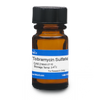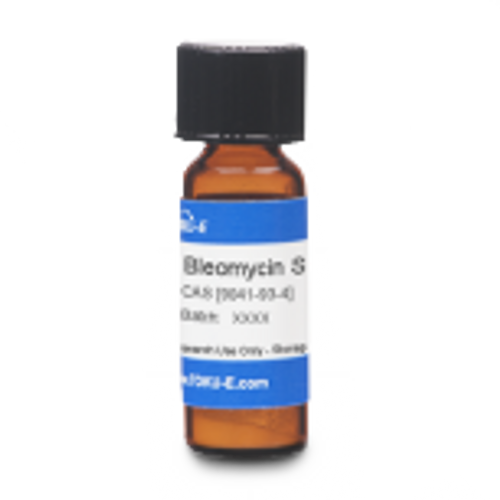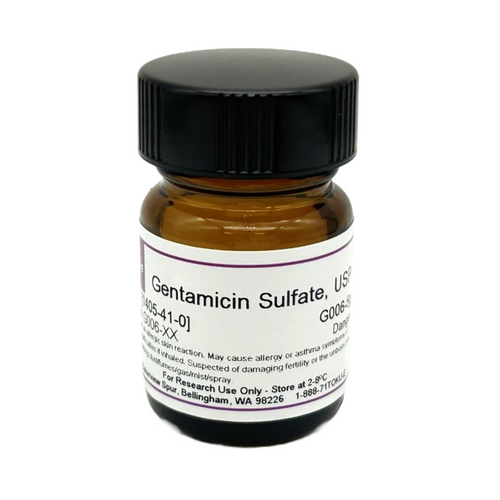Tobramycin Sulfate, USP is an aminoglycoside antibiotic derived from Streptomyces tenebrarius. Tobramycin is a member of a broad-spectrum antibiotic complex, nebramycin, that was originally isolated in 1967 by Eli Lilly and Company. The nebramycin complex was separated into various factors, with nebramycin factor 6 showing in vitro activity of clinical usefulness. Nebramycin factor 6 was subsequently designated tobramycin.
Tobramycin Sulfate is a bactericidal protein synthesis inhibitor, able to bind to the 16S rRNA of the 30S ribosomal subunit, inhibiting translocation, and eliciting miscoding of the proteins. Tobramycin Sulfate has also shown a disruptive effect on the outer membrane of Gram-negative bacteria at high concentrations.
Tobramycin Sulfate is active against Gram-negative bacteria and is frequently used to eliminate Pseudomonas aeruginosa causing cystic fibrosis. Tobramycin like other aminoglycosides can be used to treat Gram-positive bacteria, but other types of antibiotics are more potent and less toxic. Tobramycin shows activity against mycobacteria but is mostly ineffective against fungi and viruses. Tobramycin Sulfate is freely soluble in aqueous solution.
We also offer:
- Tobramycin (T009)
Tobramycin Sulfate USP conforms to United States Pharmacopeia specifications.
| Mechanism of Action | Following active transport into the cell, Tobramycin Sulfate binds irreversibly to a specific aminoglycoside receptor on the bacterial 30S ribosomal subunit and interferes with the initiation complex between messenger RNA and the 30S subunit, thereby inhibiting initiation of protein synthesis, consequently leading to bacterial cell death. In addition, Tobramycin induces misreading of the mRNA template causing incorrect amino acids to be incorporated into the growing polypeptide chain, consequently interfering with protein elongation. |
| Spectrum | Tobramycin Sulfate is effective against aerobic, Gram-negative bacteria, like Acinetobacter and Enterobacter, but is particularly effective against Pseudomonas aeruginosa bacterial strains. Infections caused by Gram-positive bacteria can also be treated with aminoglycosides, like Tobramycin Sulfate, but other types of antibiotics are more potent and less damaging to the host. In the past the aminoglycosides have been used in conjunction with penicillin-related antibiotics in streptococcal infections for their synergistic effects, particularly in endocarditis. Tobramycin is mostly ineffective against anaerobic bacteria, fungi, and viruses. |
| Microbiology Applications |
Tobramycin is commonly used in clinical in vitro microbiological antimicrobial susceptibility tests (panels, discs, and MIC strips) against Gram-negative microbial isolates. Medical microbiologists use AST results to recommend antibiotic treatment options. Representative MIC values include:
It is used for Pseudomonas aeruginosa that causes lung infections and is used in combination with other antibiotics to treat the bacteria causing urinary tract infections, gynecologic infections, endocarditis, pneumonia, sepsis, peritonitis, respiratory infections, osteomyelitis, and other soft-tissue infections. Microfluidic droplet systems are popular analytical methods used in antimicrobial susceptibility testing (AST) to help study antimicrobial resistance (AMR). Droplet methods have many advantages over conventional AST methods. Authors used several antibiotics from TOKU-E including Tobramycin to review the physicochemical properties to predict retention of antibiotics in droplets (Ruszczak et al, 2023).
|
| Plant Biology Applications |
Tobramycin Sulfate can be used to eliminate Pseudomonas aeruginosa in plants, soil, and water. Tobramycin has been used in conjunction with the aac(6′)-Ie/aph(2″)-Ia gene as an efficient selection system for the transformation of chloroplasts. The system’s efficiency is comparable to the selection of transplastomic lines with spectinomycin resistance conferred by the resistance gene aadA. Importantly, no spontaneous antibiotic resistance mutants appeared under Tobramycin selection.
|
| Molecular Formula |
C18H37N5O9 · H2SO4 |
| References |
Davis BD (1987) Mechanism of bactericidal action of aminoglycosides. Microbiol. Rev. 51(3):341-50 Ruszczak A, Jankowski P, Vasantham S, Scheler O and Garstiecki P (2023) Physicochemical properties predict retention of antibiotics in water-in-oil droplets. Anal. Chem. 95(2): 1574−1581 PMID 36598882 Tabatabaei I, Ruf S and Bock R (2016) A bifunctional aminoglycoside acetyltransferase/phosphotransferase conferring Tobramycin resistance provides an efficient selectable marker for plastid transformation. Plant Molec. Biol. 93(3):269-281 |








